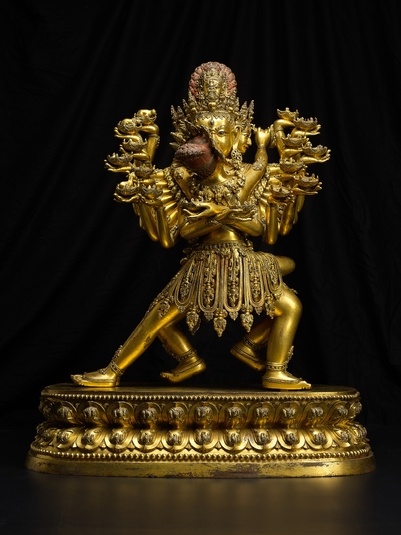
Item: Hevajra (Buddhist Deity) - (Hevajra Tantra)
| Origin Location | China |
|---|---|
| Date Range | 1400 - 1499 |
| Lineages | Buddhist |
| Size | 66cm (25.98in) high |
| Material | Metal, Mercuric Gild |
| Collection | Private |
Shri Hevajra according to the Shri Hevajra Tantra Tradition.
Shri Hevajra (Tib. Kye-dorje) is an extremely complex Tantric Buddhist meditational deity (Tib. yidam) layered in symbolic meaning. His appearance can be challenging for the uninitiated as well as the advanced learner. A textual description is almost always required to grasp the various elements of the form. He is semi-wrathful (Tib. shi-ma-dro) in appearance, with eight faces, sixteen hands and four legs. The principal face is slightly larger than the others and a wrathful head is placed atop the others which form a circle of faces below. The upward flowing flame-like hair is painted orange. The sixteen hands each hold a skull bowl. The bowls of the right hands contain animals representing various illnesses and diseases which face towards Hevajra. The bowls of the left hands hold Indian Hindu gods and face outwards representing skills, powers and abilities. Hevajra absorbs all of the bad that affects beings and dispenses whatever is good and desired.
With four legs, the two feet of the first pair are placed on the ground, represented by a double lotus base, while the legs of the second, or back pair, are drawn up in a dancing posture. Adorned with a crown of skulls, bone ornaments and a necklace of freshly severed heads he has the appearance of being slightly wrathful and slightly peaceful. The first pair of arms are folded at the heart and embrace the consort.
The consort vajra Nairatmya (Tib. Dagmema) has one face and two hands holding a curved knife and skull bowl. Adorned with bone ornaments and a necklace of fifty skulls she stands with the left leg down and the right raised to embrace Hevajra. Typically the embracing couple would be framed by a circle of fire representing the wisdom of enlightenment.
Hevajra is a construct, a creation, a model used in meditation. It functions as a large mnemonic device layered in overlapping meanings drawn from all levels of Buddhist morality teachings, dependent arising, and the deepest philosophies on the subject of emptiness. The description of Hevajra originates with the Sanskrit, the Shri Hevajra Tantra. A series of supplementary commentarial tantras are also included in what is called the Cycle of Hevajra Tantras, included among those is the Vajra Panjara Tantra from where Panjarnata Mahakala originates.
The lineages and traditions of Hevajra spread from India in the ninth and tenth centuries northward and were practiced and promoted primarily by the Sakya and Kagyu traditions of Tibetan Buddhism. This sculpture is remarkable for the beauty of the many faces, the detail of the ornaments and the very large overall size (26 in., 66 cm. in height). Although popular with earlier traditions of Buddhism this sculpture was possibly a gift from the Yongle Emperor (r.1403–1424) to the Tibetan Lama Shakya Yeshe (1354—1435) of the Gelug Tradition and founder of the university style Sera Monastery. Shakya Yeshe was the main Tibetan teacher of the Yongle Emperor until his death. Their relationship and gift exchange was the source for the construction of Sera Monastery (founded in 1419, just north of Lhasa), which is one of the three most important Gelugpa monasteries in the Tibetan capital.
Jeff Watt 1-2024
Buddhist Deity: Hevajra Sculpture (Masterworks)
Subject: Video - Three Treasures at Sotheby's, New York (March, 2024)
Buddhist Deity: Hevajra Main Page
Collection: Sotheby's New York (Sculpture, March, 2024)



